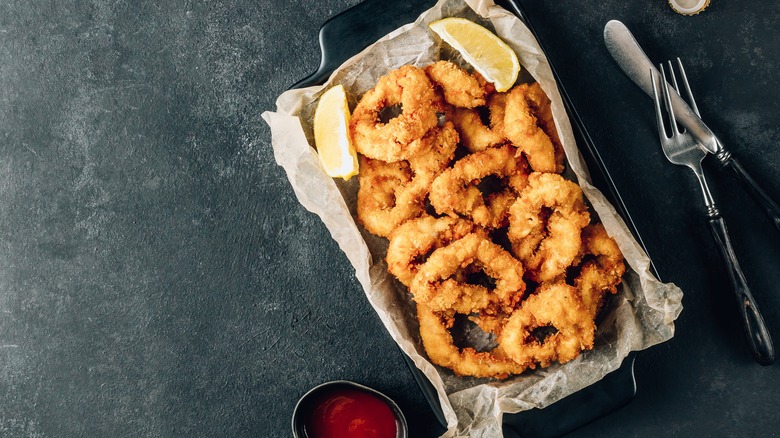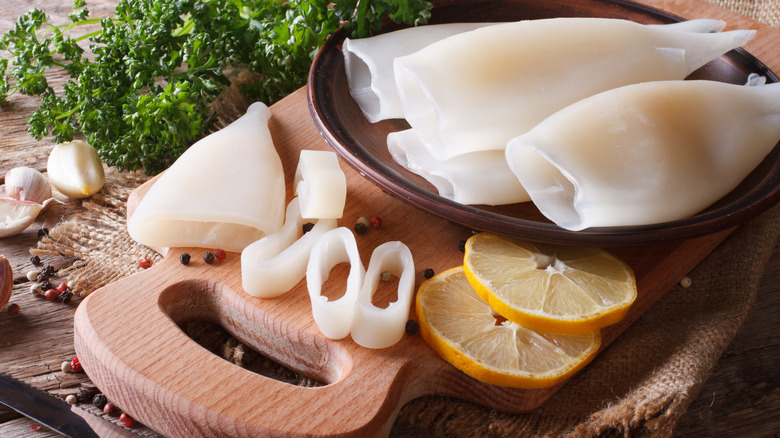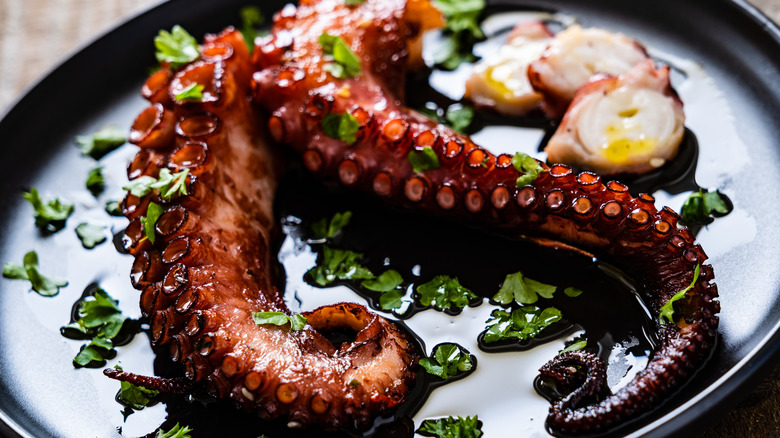Is There Really A Difference Between Calamari And Squid?
You've probably dined on squid at one point or another. When prepared, the tiny, 10-tentacled triangular creature has a sweetened taste with a firm structure. It can be likened to shrimp or lobster in this way, but relative to mackerel or tuna, squid is a sea critter that only partially tastes like seafood. This makes it a fantastic option to include in many unexpected entrees and desserts, such as squid ink pasta or gelato.
Known as spaghetti al nero di seppia in Italy, squid ink pasta is a deeply enticing dish with thick-cut noodles dyed black in color. It adds a savory umami flavor to other marine-centered meals while simultaneously reducing food waste. The delicacy of this pasta dish is continually revered for its unique taste and hue. Similarly, squid ink gelato is enjoyed in other areas of the world, like St. George, Utah. The play on everything sweet, salty, and briny is enhanced with Sailor's Vanilla by Devon James Roberts.
Breaded and fried squid served with freshly squeezed lemon and a crack of salt is what we know as calamari. Yet, this name can refer to all of the above dishes because the Italian translation for squid is "calamari. So, suppose a meal utilizes any part of the squid, including the ink or flesh. In that case, it can technically be called calamari.
George Mahe summed it up in St. Louis Magazine: "The most common (and accepted) explanation is that calamari (which means "squid" in Italian) is simply the culinary name of dishes containing squid."
Squid is sometimes served alive around the world
For better or worse, there are multiple ways to enjoy squid worldwide. Italian calamari (also known as totani or seppie) can be prepared like your traditional fried halos, or it can be rendered into more exotic dishes, such as calamari ripieni. Here, the squid is stuffed with various strong-tasting elements, like garlic, capers, and onions, and served with a ladle of tomato sauce. Calamari tagine is popular in Mediterranean countries, including Egypt and Morocco. Sliced squid is stewed and simmered in a spicy tomato mixture with rice.
In Thailand, however, you can expect to eat fresh squid — and by fresh, we mean alive. What has become known as the "squid shot" has garnered massive attention for its controversial means of consumption. Essentially, a small squid is served in a shot glass filled with spicy chili sauce. As it moves about, the squid unintentionally soaks up the sauce before the consumer ingests it. Not every popular food trend should be followed, though. Between the natural bacteria and parasites often located in raw seafood, reports of chronic food poisoning have been associated with squid shots. Katsu ika odori don ("dancing squid") is similarly served with zombie-like squid in Japan. Once the squid has been — as TikTok calls it — "unalived," the bottom half is placed over a bed of noodles. Soy sauce is then drizzled on top, causing the tentacles to "dance" from the sodium. If you're particularly squeamish, we recommend sitting this one out.
How does squid compare to the octopus and cuttlefish?
Squids are often mistaken for octopus and cuttlefish due to their similar appearance and phylum. However, they couldn't be more different in preparation, taste, and texture.
One of the most glaring differences between the squid and octopus is the detail within its tentacles. Octopuses have rows of large suckers decorating the tissue beneath each arm, which can make the octopus challenging to eat if not prepared correctly. Poaching or simmering in a pot of water allows the tentacle's fibrous muscles to tenderize. Then, the octopus can be placed on a heated flat surface, such as a grill or pan, and cooked to your liking. Everything but the hardened beak is typically included, though you can opt out of using the head. Octopus meat may taste richer or more complex than squid, but the squid's more petite body and lack of large suckers allow it to be easily prepared into ring-sized and deep-fried snacks.
Cuttlefish is a unique combination of both octopus and squid. Like the octopus, this creature has a thicker body and tentacles that can provide a hearty meal. Yet, its meat more closely resembles the squid's in that it is tougher and sweeter. While the head of the squid is one of the primary parts we consume, this would not entirely fair well with the cuttlefish. This part takes a few extra steps compared to the smaller critter — removing the guts and inner membrane from the top before slicing the outer skin into rings.


